FORD BRONCO 2023 Owners Manual
Manufacturer: FORD, Model Year: 2023, Model line: BRONCO, Model: FORD BRONCO 2023Pages: 642, PDF Size: 14.71 MB
Page 191 of 642
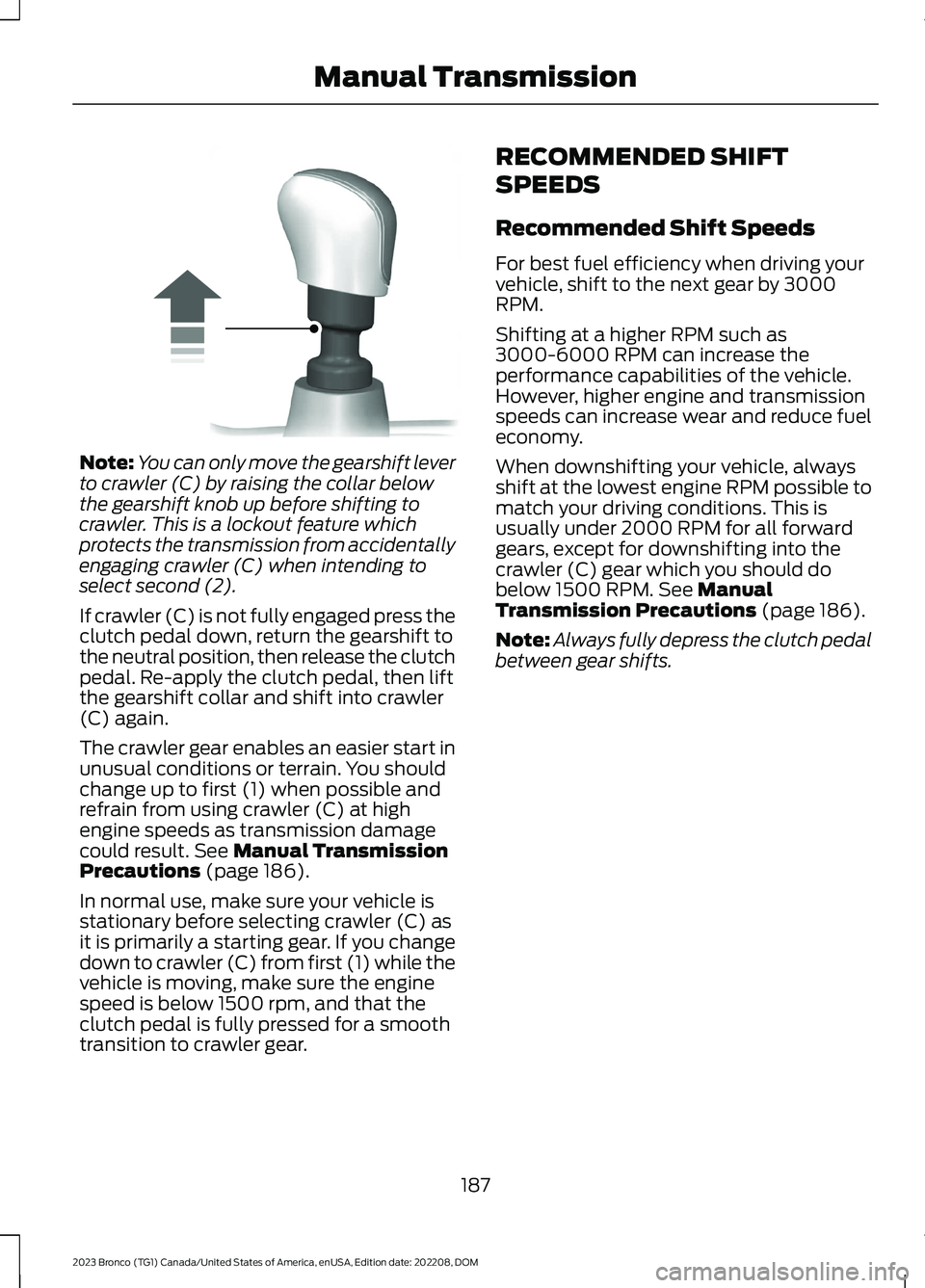
Note:You can only move the gearshift leverto crawler (C) by raising the collar belowthe gearshift knob up before shifting tocrawler. This is a lockout feature whichprotects the transmission from accidentallyengaging crawler (C) when intending toselect second (2).
If crawler (C) is not fully engaged press theclutch pedal down, return the gearshift tothe neutral position, then release the clutchpedal. Re-apply the clutch pedal, then liftthe gearshift collar and shift into crawler(C) again.
The crawler gear enables an easier start inunusual conditions or terrain. You shouldchange up to first (1) when possible andrefrain from using crawler (C) at highengine speeds as transmission damagecould result. See Manual TransmissionPrecautions (page 186).
In normal use, make sure your vehicle isstationary before selecting crawler (C) asit is primarily a starting gear. If you changedown to crawler (C) from first (1) while thevehicle is moving, make sure the enginespeed is below 1500 rpm, and that theclutch pedal is fully pressed for a smoothtransition to crawler gear.
RECOMMENDED SHIFT
SPEEDS
Recommended Shift Speeds
For best fuel efficiency when driving yourvehicle, shift to the next gear by 3000RPM.
Shifting at a higher RPM such as3000-6000 RPM can increase theperformance capabilities of the vehicle.However, higher engine and transmissionspeeds can increase wear and reduce fueleconomy.
When downshifting your vehicle, alwaysshift at the lowest engine RPM possible tomatch your driving conditions. This isusually under 2000 RPM for all forwardgears, except for downshifting into thecrawler (C) gear which you should dobelow 1500 RPM. See ManualTransmission Precautions (page 186).
Note:Always fully depress the clutch pedalbetween gear shifts.
187
2023 Bronco (TG1) Canada/United States of America, enUSA, Edition date: 202208, DOMManual TransmissionE99067
Page 192 of 642
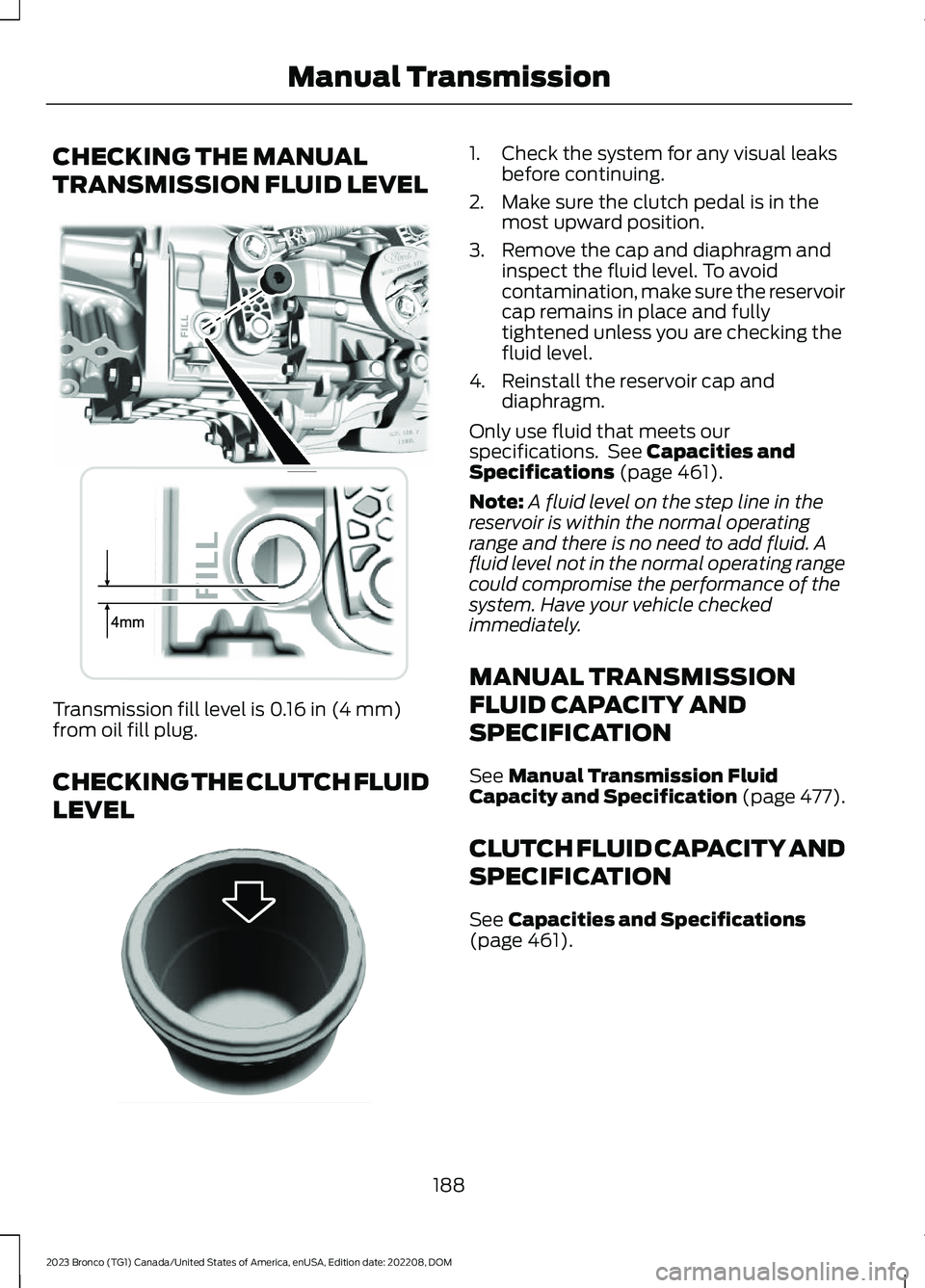
CHECKING THE MANUAL
TRANSMISSION FLUID LEVEL
Transmission fill level is 0.16 in (4 mm)from oil fill plug.
CHECKING THE CLUTCH FLUID
LEVEL
1.Check the system for any visual leaksbefore continuing.
2.Make sure the clutch pedal is in themost upward position.
3.Remove the cap and diaphragm andinspect the fluid level. To avoidcontamination, make sure the reservoircap remains in place and fullytightened unless you are checking thefluid level.
4.Reinstall the reservoir cap anddiaphragm.
Only use fluid that meets ourspecifications. See Capacities andSpecifications (page 461).
Note:A fluid level on the step line in thereservoir is within the normal operatingrange and there is no need to add fluid. Afluid level not in the normal operating rangecould compromise the performance of thesystem. Have your vehicle checkedimmediately.
MANUAL TRANSMISSION
FLUID CAPACITY AND
SPECIFICATION
See Manual Transmission FluidCapacity and Specification (page 477).
CLUTCH FLUID CAPACITY AND
SPECIFICATION
See Capacities and Specifications(page 461).
188
2023 Bronco (TG1) Canada/United States of America, enUSA, Edition date: 202208, DOMManual TransmissionE339771 E310419
Page 193 of 642
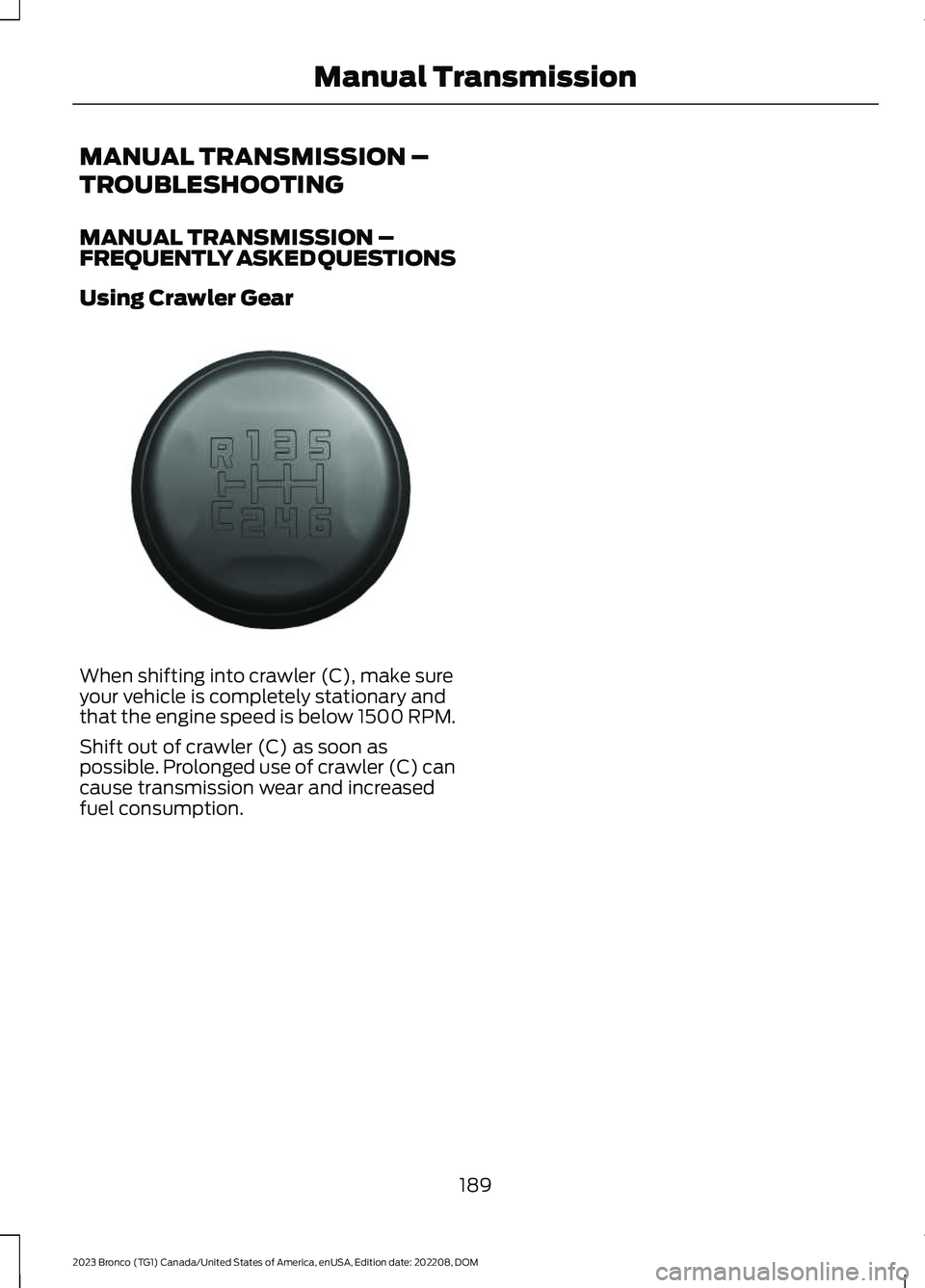
MANUAL TRANSMISSION –
TROUBLESHOOTING
MANUAL TRANSMISSION –FREQUENTLY ASKED QUESTIONS
Using Crawler Gear
When shifting into crawler (C), make sureyour vehicle is completely stationary andthat the engine speed is below 1500 RPM.
Shift out of crawler (C) as soon aspossible. Prolonged use of crawler (C) cancause transmission wear and increasedfuel consumption.
189
2023 Bronco (TG1) Canada/United States of America, enUSA, Edition date: 202208, DOMManual TransmissionE322877
Page 194 of 642
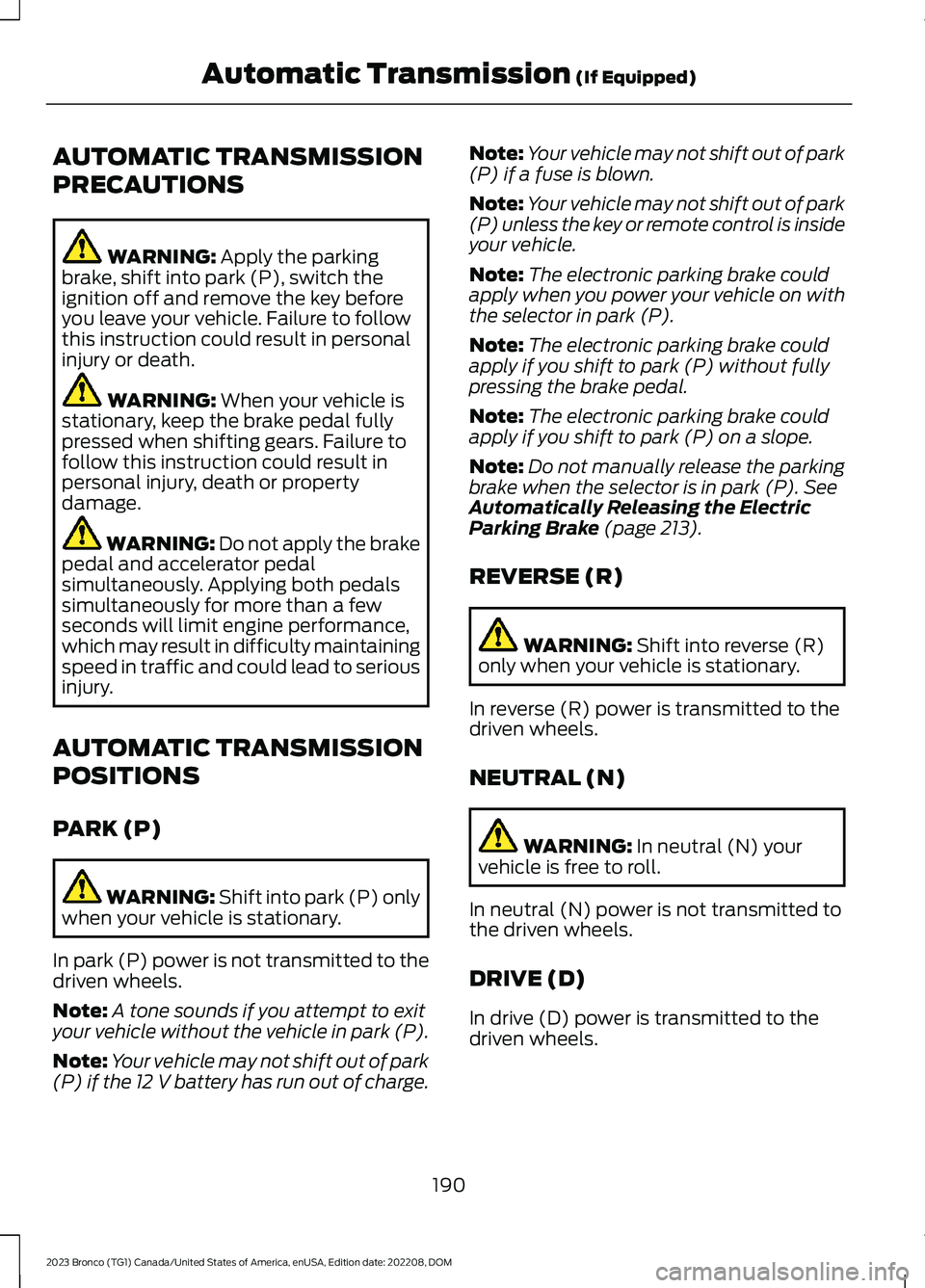
AUTOMATIC TRANSMISSION
PRECAUTIONS
WARNING: Apply the parkingbrake, shift into park (P), switch theignition off and remove the key beforeyou leave your vehicle. Failure to followthis instruction could result in personalinjury or death.
WARNING: When your vehicle isstationary, keep the brake pedal fullypressed when shifting gears. Failure tofollow this instruction could result inpersonal injury, death or propertydamage.
WARNING: Do not apply the brakepedal and accelerator pedalsimultaneously. Applying both pedalssimultaneously for more than a fewseconds will limit engine performance,which may result in difficulty maintainingspeed in traffic and could lead to seriousinjury.
AUTOMATIC TRANSMISSION
POSITIONS
PARK (P)
WARNING: Shift into park (P) onlywhen your vehicle is stationary.
In park (P) power is not transmitted to thedriven wheels.
Note:A tone sounds if you attempt to exityour vehicle without the vehicle in park (P).
Note:Your vehicle may not shift out of park(P) if the 12 V battery has run out of charge.
Note:Your vehicle may not shift out of park(P) if a fuse is blown.
Note:Your vehicle may not shift out of park(P) unless the key or remote control is insideyour vehicle.
Note:The electronic parking brake couldapply when you power your vehicle on withthe selector in park (P).
Note:The electronic parking brake couldapply if you shift to park (P) without fullypressing the brake pedal.
Note:The electronic parking brake couldapply if you shift to park (P) on a slope.
Note:Do not manually release the parkingbrake when the selector is in park (P). SeeAutomatically Releasing the ElectricParking Brake (page 213).
REVERSE (R)
WARNING: Shift into reverse (R)only when your vehicle is stationary.
In reverse (R) power is transmitted to thedriven wheels.
NEUTRAL (N)
WARNING: In neutral (N) yourvehicle is free to roll.
In neutral (N) power is not transmitted tothe driven wheels.
DRIVE (D)
In drive (D) power is transmitted to thedriven wheels.
190
2023 Bronco (TG1) Canada/United States of America, enUSA, Edition date: 202208, DOMAutomatic Transmission (If Equipped)
Page 195 of 642
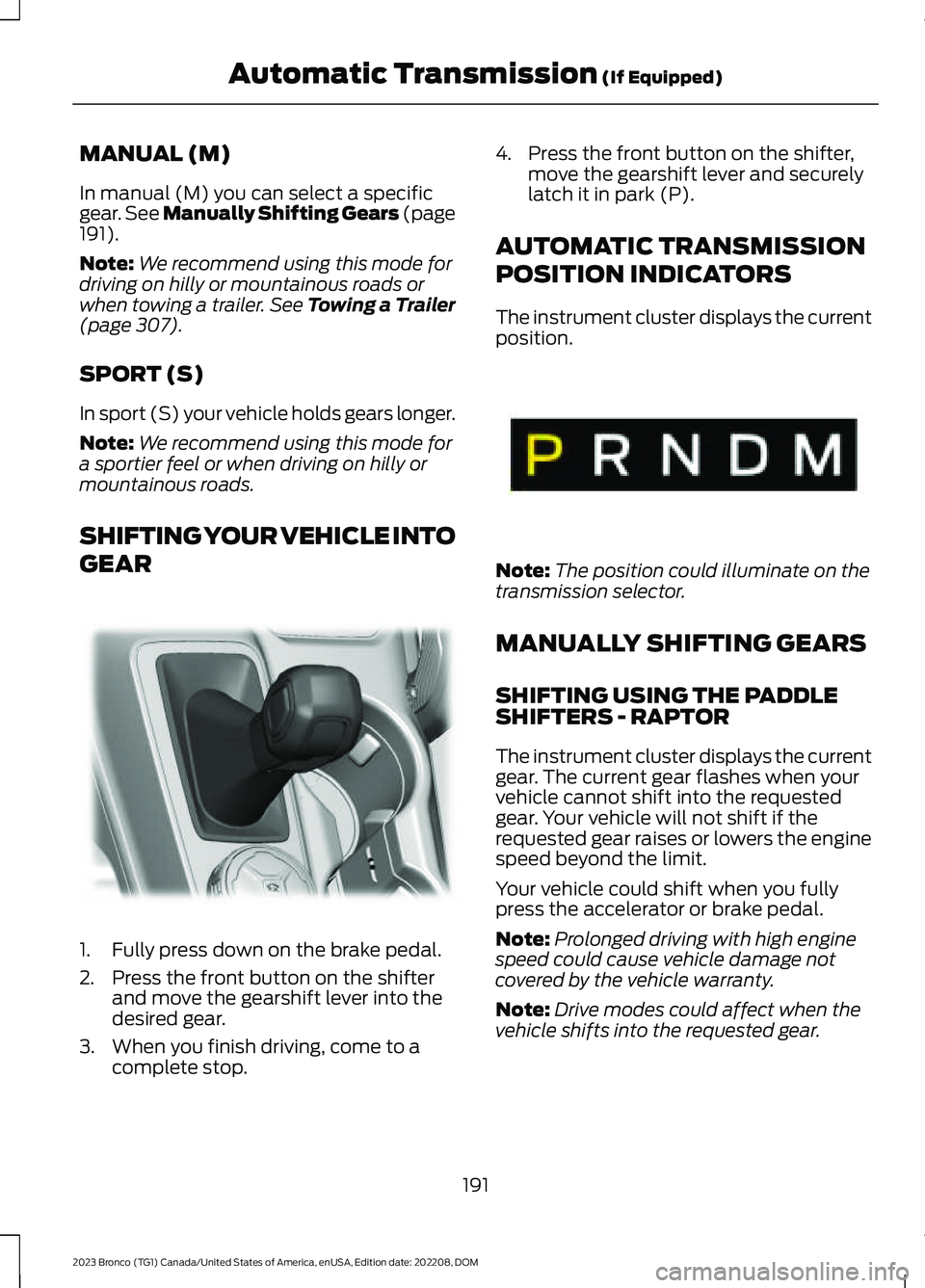
MANUAL (M)
In manual (M) you can select a specificgear. See Manually Shifting Gears (page191).
Note:We recommend using this mode fordriving on hilly or mountainous roads orwhen towing a trailer. See Towing a Trailer(page 307).
SPORT (S)
In sport (S) your vehicle holds gears longer.
Note:We recommend using this mode fora sportier feel or when driving on hilly ormountainous roads.
SHIFTING YOUR VEHICLE INTO
GEAR
1.Fully press down on the brake pedal.
2.Press the front button on the shifterand move the gearshift lever into thedesired gear.
3.When you finish driving, come to acomplete stop.
4.Press the front button on the shifter,move the gearshift lever and securelylatch it in park (P).
AUTOMATIC TRANSMISSION
POSITION INDICATORS
The instrument cluster displays the currentposition.
Note:The position could illuminate on thetransmission selector.
MANUALLY SHIFTING GEARS
SHIFTING USING THE PADDLESHIFTERS - RAPTOR
The instrument cluster displays the currentgear. The current gear flashes when yourvehicle cannot shift into the requestedgear. Your vehicle will not shift if therequested gear raises or lowers the enginespeed beyond the limit.
Your vehicle could shift when you fullypress the accelerator or brake pedal.
Note:Prolonged driving with high enginespeed could cause vehicle damage notcovered by the vehicle warranty.
Note:Drive modes could affect when thevehicle shifts into the requested gear.
191
2023 Bronco (TG1) Canada/United States of America, enUSA, Edition date: 202208, DOMAutomatic Transmission (If Equipped)E324063 E341776
Page 196 of 642
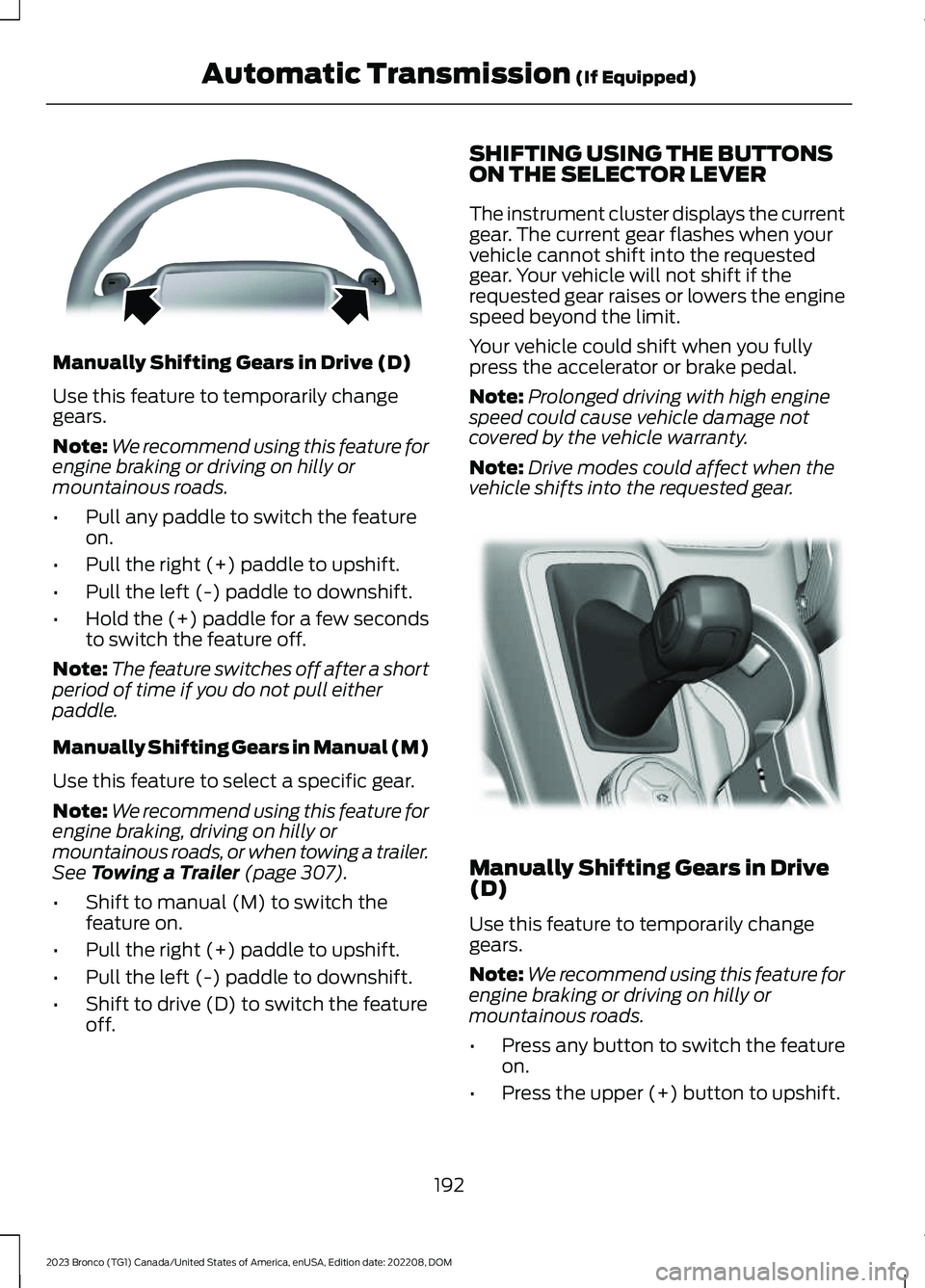
Manually Shifting Gears in Drive (D)
Use this feature to temporarily changegears.
Note:We recommend using this feature forengine braking or driving on hilly ormountainous roads.
•Pull any paddle to switch the featureon.
•Pull the right (+) paddle to upshift.
•Pull the left (-) paddle to downshift.
•Hold the (+) paddle for a few secondsto switch the feature off.
Note:The feature switches off after a shortperiod of time if you do not pull eitherpaddle.
Manually Shifting Gears in Manual (M)
Use this feature to select a specific gear.
Note:We recommend using this feature forengine braking, driving on hilly ormountainous roads, or when towing a trailer.See Towing a Trailer (page 307).
•Shift to manual (M) to switch thefeature on.
•Pull the right (+) paddle to upshift.
•Pull the left (-) paddle to downshift.
•Shift to drive (D) to switch the featureoff.
SHIFTING USING THE BUTTONSON THE SELECTOR LEVER
The instrument cluster displays the currentgear. The current gear flashes when yourvehicle cannot shift into the requestedgear. Your vehicle will not shift if therequested gear raises or lowers the enginespeed beyond the limit.
Your vehicle could shift when you fullypress the accelerator or brake pedal.
Note:Prolonged driving with high enginespeed could cause vehicle damage notcovered by the vehicle warranty.
Note:Drive modes could affect when thevehicle shifts into the requested gear.
Manually Shifting Gears in Drive(D)
Use this feature to temporarily changegears.
Note:We recommend using this feature forengine braking or driving on hilly ormountainous roads.
•Press any button to switch the featureon.
•Press the upper (+) button to upshift.
192
2023 Bronco (TG1) Canada/United States of America, enUSA, Edition date: 202208, DOMAutomatic Transmission (If Equipped)E144821 E324063
Page 197 of 642
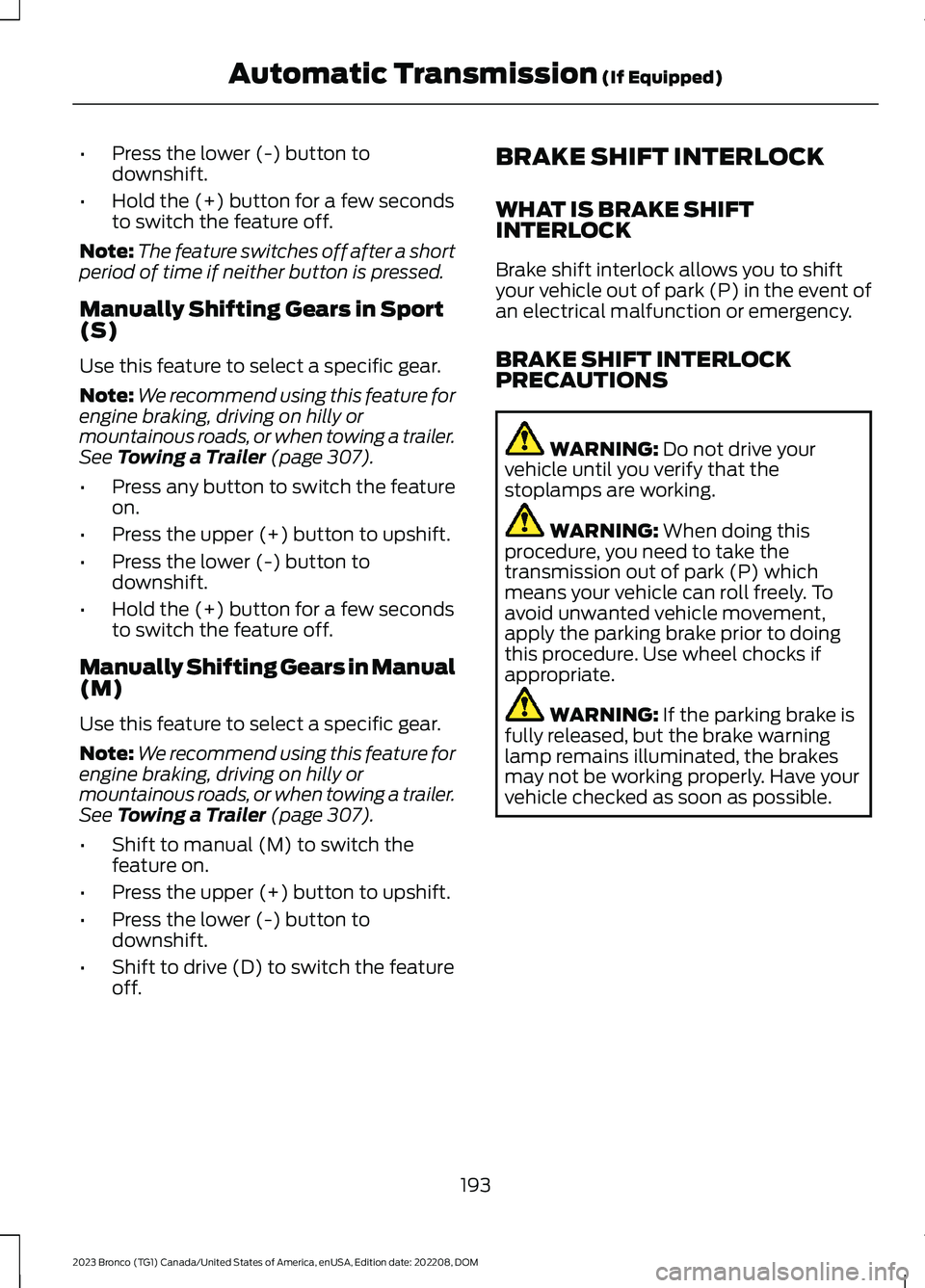
•Press the lower (-) button todownshift.
•Hold the (+) button for a few secondsto switch the feature off.
Note:The feature switches off after a shortperiod of time if neither button is pressed.
Manually Shifting Gears in Sport(S)
Use this feature to select a specific gear.
Note:We recommend using this feature forengine braking, driving on hilly ormountainous roads, or when towing a trailer.See Towing a Trailer (page 307).
•Press any button to switch the featureon.
•Press the upper (+) button to upshift.
•Press the lower (-) button todownshift.
•Hold the (+) button for a few secondsto switch the feature off.
Manually Shifting Gears in Manual(M)
Use this feature to select a specific gear.
Note:We recommend using this feature forengine braking, driving on hilly ormountainous roads, or when towing a trailer.See Towing a Trailer (page 307).
•Shift to manual (M) to switch thefeature on.
•Press the upper (+) button to upshift.
•Press the lower (-) button todownshift.
•Shift to drive (D) to switch the featureoff.
BRAKE SHIFT INTERLOCK
WHAT IS BRAKE SHIFTINTERLOCK
Brake shift interlock allows you to shiftyour vehicle out of park (P) in the event ofan electrical malfunction or emergency.
BRAKE SHIFT INTERLOCKPRECAUTIONS
WARNING: Do not drive yourvehicle until you verify that thestoplamps are working.
WARNING: When doing thisprocedure, you need to take thetransmission out of park (P) whichmeans your vehicle can roll freely. Toavoid unwanted vehicle movement,apply the parking brake prior to doingthis procedure. Use wheel chocks ifappropriate.
WARNING: If the parking brake isfully released, but the brake warninglamp remains illuminated, the brakesmay not be working properly. Have yourvehicle checked as soon as possible.
193
2023 Bronco (TG1) Canada/United States of America, enUSA, Edition date: 202208, DOMAutomatic Transmission (If Equipped)
Page 198 of 642
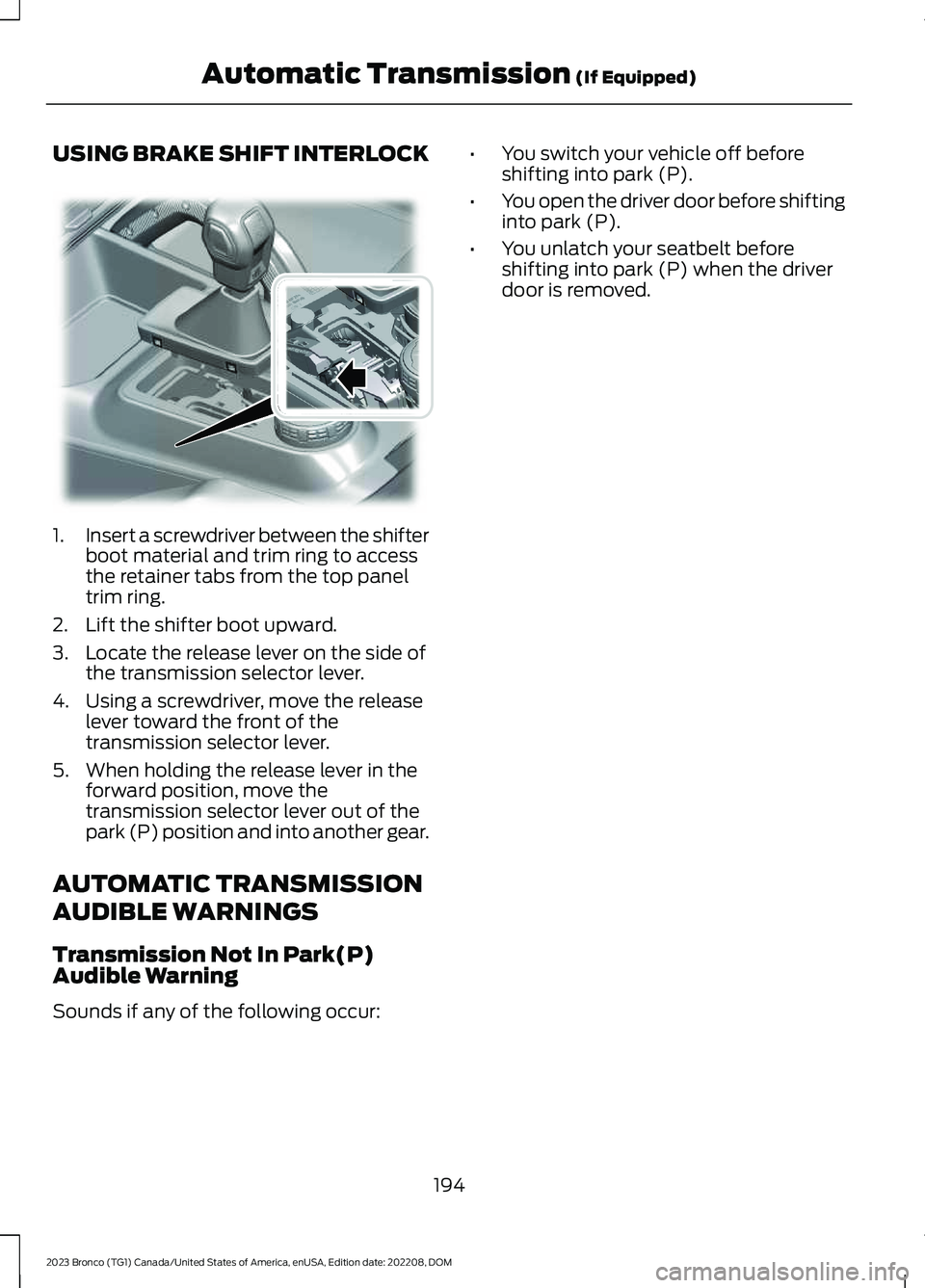
USING BRAKE SHIFT INTERLOCK
1.Insert a screwdriver between the shifterboot material and trim ring to accessthe retainer tabs from the top paneltrim ring.
2.Lift the shifter boot upward.
3.Locate the release lever on the side ofthe transmission selector lever.
4.Using a screwdriver, move the releaselever toward the front of thetransmission selector lever.
5.When holding the release lever in theforward position, move thetransmission selector lever out of thepark (P) position and into another gear.
AUTOMATIC TRANSMISSION
AUDIBLE WARNINGS
Transmission Not In Park(P)Audible Warning
Sounds if any of the following occur:
•You switch your vehicle off beforeshifting into park (P).
•You open the driver door before shiftinginto park (P).
•You unlatch your seatbelt beforeshifting into park (P) when the driverdoor is removed.
194
2023 Bronco (TG1) Canada/United States of America, enUSA, Edition date: 202208, DOMAutomatic Transmission (If Equipped)E346836
Page 199 of 642
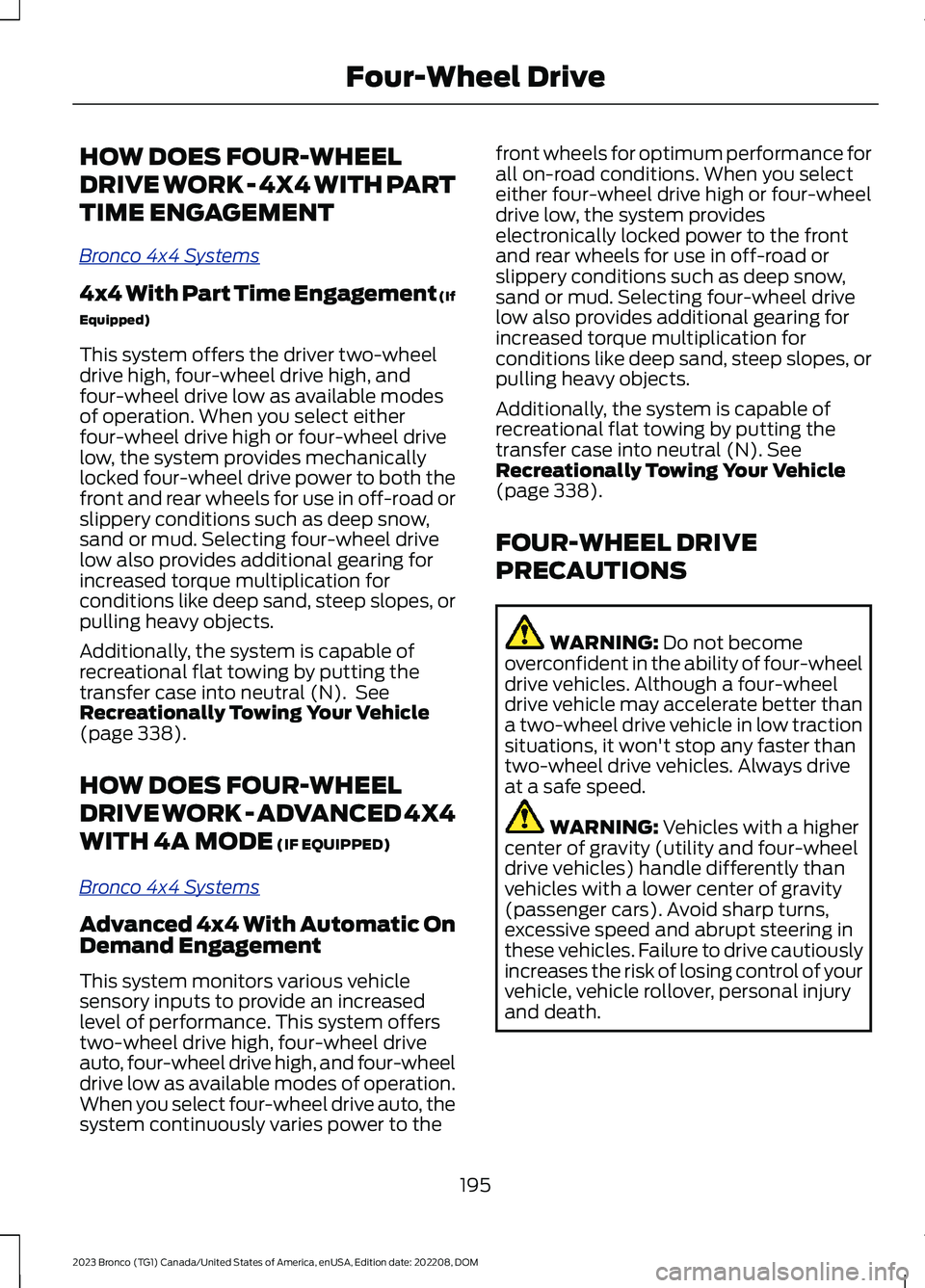
HOW DOES FOUR-WHEEL
DRIVE WORK - 4X4 WITH PART
TIME ENGAGEMENT
Bronco 4x4 Systems
4x4 With Part Time Engagement (If
Equipped)
This system offers the driver two-wheeldrive high, four-wheel drive high, andfour-wheel drive low as available modesof operation. When you select eitherfour-wheel drive high or four-wheel drivelow, the system provides mechanicallylocked four-wheel drive power to both thefront and rear wheels for use in off-road orslippery conditions such as deep snow,sand or mud. Selecting four-wheel drivelow also provides additional gearing forincreased torque multiplication forconditions like deep sand, steep slopes, orpulling heavy objects.
Additionally, the system is capable ofrecreational flat towing by putting thetransfer case into neutral (N). SeeRecreationally Towing Your Vehicle(page 338).
HOW DOES FOUR-WHEEL
DRIVE WORK - ADVANCED 4X4
WITH 4A MODE (IF EQUIPPED)
Bronco 4x4 Systems
Advanced 4x4 With Automatic OnDemand Engagement
This system monitors various vehiclesensory inputs to provide an increasedlevel of performance. This system offerstwo-wheel drive high, four-wheel driveauto, four-wheel drive high, and four-wheeldrive low as available modes of operation.When you select four-wheel drive auto, thesystem continuously varies power to the
front wheels for optimum performance forall on-road conditions. When you selecteither four-wheel drive high or four-wheeldrive low, the system provideselectronically locked power to the frontand rear wheels for use in off-road orslippery conditions such as deep snow,sand or mud. Selecting four-wheel drivelow also provides additional gearing forincreased torque multiplication forconditions like deep sand, steep slopes, orpulling heavy objects.
Additionally, the system is capable ofrecreational flat towing by putting thetransfer case into neutral (N). SeeRecreationally Towing Your Vehicle(page 338).
FOUR-WHEEL DRIVE
PRECAUTIONS
WARNING: Do not becomeoverconfident in the ability of four-wheeldrive vehicles. Although a four-wheeldrive vehicle may accelerate better thana two-wheel drive vehicle in low tractionsituations, it won't stop any faster thantwo-wheel drive vehicles. Always driveat a safe speed.
WARNING: Vehicles with a highercenter of gravity (utility and four-wheeldrive vehicles) handle differently thanvehicles with a lower center of gravity(passenger cars). Avoid sharp turns,excessive speed and abrupt steering inthese vehicles. Failure to drive cautiouslyincreases the risk of losing control of yourvehicle, vehicle rollover, personal injuryand death.
195
2023 Bronco (TG1) Canada/United States of America, enUSA, Edition date: 202208, DOMFour-Wheel Drive
Page 200 of 642
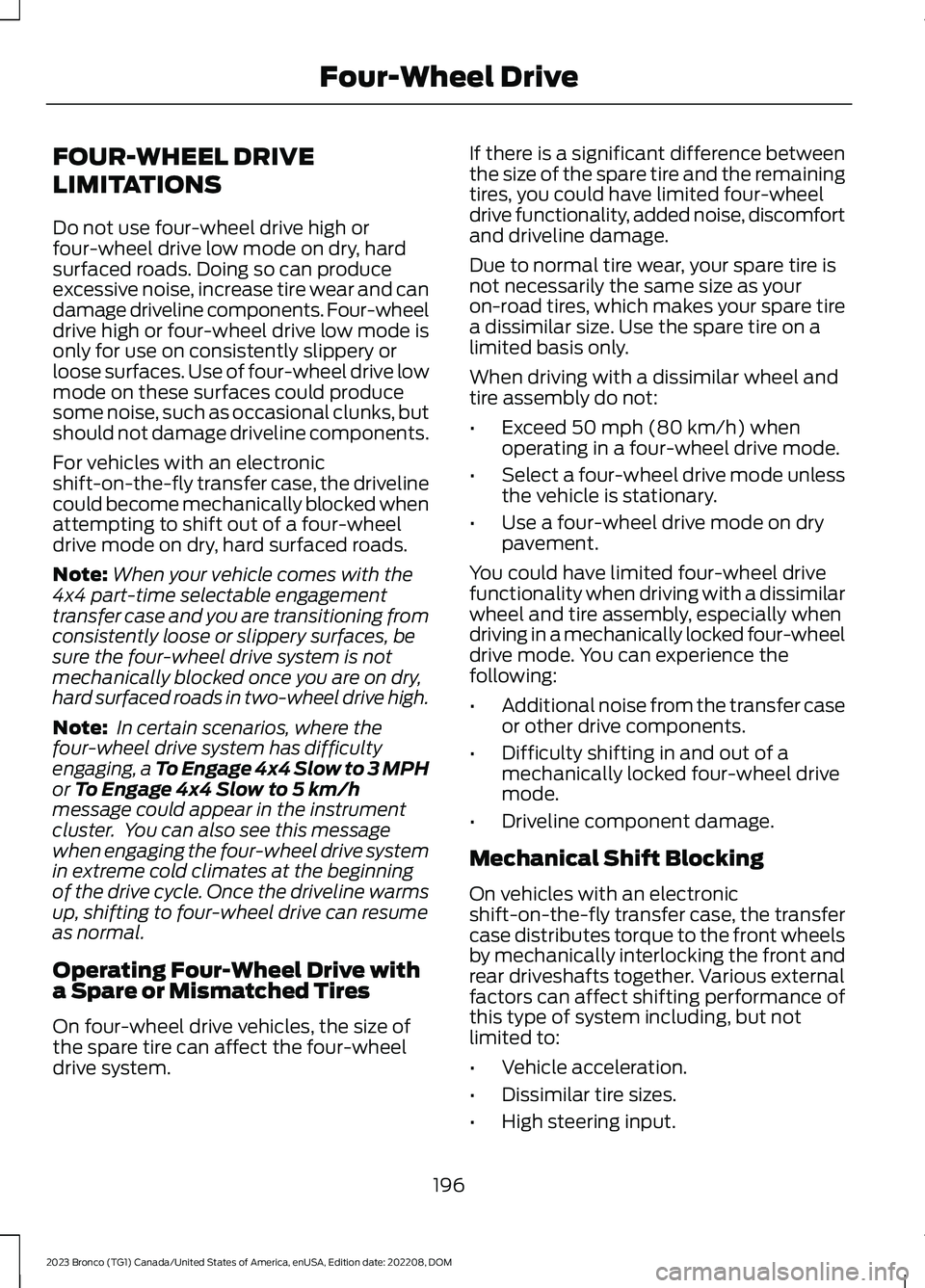
FOUR-WHEEL DRIVE
LIMITATIONS
Do not use four-wheel drive high orfour-wheel drive low mode on dry, hardsurfaced roads. Doing so can produceexcessive noise, increase tire wear and candamage driveline components. Four-wheeldrive high or four-wheel drive low mode isonly for use on consistently slippery orloose surfaces. Use of four-wheel drive lowmode on these surfaces could producesome noise, such as occasional clunks, butshould not damage driveline components.
For vehicles with an electronicshift-on-the-fly transfer case, the drivelinecould become mechanically blocked whenattempting to shift out of a four-wheeldrive mode on dry, hard surfaced roads.
Note:When your vehicle comes with the4x4 part-time selectable engagementtransfer case and you are transitioning fromconsistently loose or slippery surfaces, besure the four-wheel drive system is notmechanically blocked once you are on dry,hard surfaced roads in two-wheel drive high.
Note: In certain scenarios, where thefour-wheel drive system has difficultyengaging, a To Engage 4x4 Slow to 3 MPHor To Engage 4x4 Slow to 5 km/hmessage could appear in the instrumentcluster. You can also see this messagewhen engaging the four-wheel drive systemin extreme cold climates at the beginningof the drive cycle. Once the driveline warmsup, shifting to four-wheel drive can resumeas normal.
Operating Four-Wheel Drive witha Spare or Mismatched Tires
On four-wheel drive vehicles, the size ofthe spare tire can affect the four-wheeldrive system.
If there is a significant difference betweenthe size of the spare tire and the remainingtires, you could have limited four-wheeldrive functionality, added noise, discomfortand driveline damage.
Due to normal tire wear, your spare tire isnot necessarily the same size as youron-road tires, which makes your spare tirea dissimilar size. Use the spare tire on alimited basis only.
When driving with a dissimilar wheel andtire assembly do not:
•Exceed 50 mph (80 km/h) whenoperating in a four-wheel drive mode.
•Select a four-wheel drive mode unlessthe vehicle is stationary.
•Use a four-wheel drive mode on drypavement.
You could have limited four-wheel drivefunctionality when driving with a dissimilarwheel and tire assembly, especially whendriving in a mechanically locked four-wheeldrive mode. You can experience thefollowing:
•Additional noise from the transfer caseor other drive components.
•Difficulty shifting in and out of amechanically locked four-wheel drivemode.
•Driveline component damage.
Mechanical Shift Blocking
On vehicles with an electronicshift-on-the-fly transfer case, the transfercase distributes torque to the front wheelsby mechanically interlocking the front andrear driveshafts together. Various externalfactors can affect shifting performance ofthis type of system including, but notlimited to:
•Vehicle acceleration.
•Dissimilar tire sizes.
•High steering input.
196
2023 Bronco (TG1) Canada/United States of America, enUSA, Edition date: 202208, DOMFour-Wheel Drive